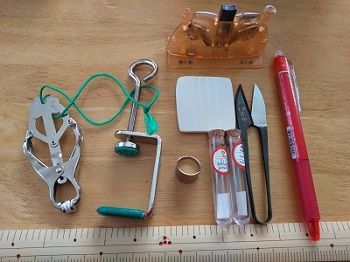Wasai : The Art of Making Kimono
For formal occassions, Japanese people usually wear kimonos. The word Kimono actually just means 'something to wear' but, these garments have become an art form and a form of fashion stretching over a long history and culture.
Yanaka sensei is a Japanese teacher at JOI online school, and she explains the tools used in Wasai, the art of kimono-making. Yanaka sensei also reads the blog in the video so that you can learn Japanese fluency better.
There is a Kanji explanation version and one without any, as well as an English translation – so you can learn Japanese vocabulary and practice your reading and listening as well.
和裁の道具
Tools for Wasai

By YANAKA Izumi

去年の七月から和裁を習い始めました。今日は私の和裁の道具をご紹介します。
まず、針とはさみです。先生や周りの人に針とはさみは良い物を使ったほうがいいと言われて買い換えました。今使っている針は広島の針です。新しい針は使いやすく、すいすいと針が進みます。写真のはさみは「糸きりはさみ」です。これもよく切れて快適です。ほかに布を切る「裁ちばさみ」もあります。裁ちばさみは母からよく切れるはさみをもらいました。
その上にある天秤のような形をした道具が「糸通し器」です。この糸通し器を使うと、ボタン一つで針に糸が通ります。これを発明した人は本当に素晴らしいと思います。一度使い始めると手放せなくなる道具です。
それから指輪のような形をしたものが「指ぬき」です。布を縫うときに指ぬきで針を押しながら縫っていきます。私はまだまだ指ぬきがうまく使えません。そして一番左側にあるクリップのような形をしたものが「けんちょう器」です。「かけはり」ともいいます。となりにある「くけ台」と一緒に使います。机にくけ台を固定して、けんちょう器で布をひっぱりながら縫うと直線がきれいに縫えます。着物の背中の部分など、長い直線を縫うときに使います。
白い四角いものは「石鹸チャコ」で、赤いのは文房具の「消えるボールペン」です。これらは布にしるしをつけるときに使います。どちらもアイロンで簡単に消えてとても便利です。一番下が和裁用のものさしです。和裁では長さを計るとき「鯨尺」という単位を使います。鯨尺の一尺は約38センチです。普通の一尺は約30センチですから少し長さが違います。
道具はそろったのですが、腕はまだまだ。これからもっと練習していろいろな物を縫えるようがんばりたいと思います。
To listen to this blog, please watch our Youtube video.
和裁(わさい)の道具(どうぐ)
去年(きょねん)の七月(しちがつ)から和裁(わさい)を習(なら)い始(はじ)めました。今日(きょう)は私(わたし)の和裁(わさい)の道具(どうぐ)をご紹介(しょうかい)します。
まず、針(はり)とはさみです。先生(せんせい)や周(まわ)りの人(ひと)に針(はり)とはさみは良(よ)い物(もの)を使(つか)ったほうがいいと言(い)われて買(か)い換(か)えました。今(いま)使(つか)っている針(はり)は広島(ひろしま)の針(はり)です。新(あたら)しい針(はり)は使(つか)いやすく、すいすいと針(はり)が進(すす)みます。写真(しゃしん)のはさみは「糸(いと)きりはさみ」です。これもよく切(き)れて快適(かいてき)です。ほかに布(ぬの)を切(き)る「裁(た)ちばさみ」もあります。裁(た)ちばさみは母(はは)からよく切(き)れるはさみをもらいました。
その上(うえ)にある天秤(てんびん)のような形(かたち)をした道具(どうぐ)が「糸通(いととお)し器(き)」です。この糸通(いととお)し器(き)を使(つか)うと、ボタン一(ひと)つで針(はり)に糸(いと)が通(とお)ります。これを発明(はつめい)した人(ひと)は本当(ほんとう)に素晴(すば)らしいと思(おも)います。一度(いちど)使(つか)い始(はじ)めると手放(てばな)せなくなる道具(どうぐ)です。
それから指輪(ゆびわ)のような形(かたち)をしたものが「指(ゆび)ぬき」です。布(ぬの)を縫(ぬ)うときに指(ゆび)ぬきで針(はり)を押(お)しながら縫(ぬ)っていきます。私(わたし)はまだまだ指(ゆび)ぬきがうまく使(つか)えません。そして一番(いちばん)左側(ひだりがわ)にあるクリップのような形(かたち)をしたものが「けんちょう器(き)」です。「かけはり」ともいいます。となりにある「くけ台(だい)」と一緒(いっしょ)に使(つか)います。机(つくえ)にくけ台(だい)を固定(こてい)して、けんちょう器で布をひっぱりながら縫うと直線がきれいに縫えます。着物の背中の部分など、長(なが)い直線(ちょくせん)を縫(ぬ)うときに使(つか)います。
白(しろ)い四角(しかく)いものは「石鹸(せっけん)チャコ」で、赤(あか)いのは文房具(ぶんぼうぐ)の「消(き)えるボールペン」です。これらは布(ぬの)にしるしをつけるときに使(つか)います。どちらもアイロンで簡単(かんたん)に消(き)えてとても便利(べんり)です。一番(いちばん)下(した)が和裁用(わさいよう)のものさしです。和裁(わさい)では長(なが)さを計(はか)るとき「鯨尺(くじらじゃく)」という単位(たんい)を使(つか)います。鯨尺(くじらじゃく)の一尺(いっしゃく)は約(やく)38センチです。普通(ふつう)の一尺(いっしゃく)は約(やく)30センチですから少(すこ)し長(なが)さが違(ちが)います。
道具(どうぐ)はそろったのですが、腕(うで)はまだまだ。これからもっと練習(れんしゅう)していろいろな物(もの)を縫(ぬ)えるようがんばりたいと思(おも)います。
Tools for Wasai
From July last year I started to learn 'Wasai' or kimono-making. Today I will introduce my kimono-making tools. First, the needles and scissors. I was told by my teacher and by people around me that I should use good quality needles and scissors., so I bought new ones.The needles I am using now are Hiroshima needles. New needles are easy to use and move along smoothly. The scissors in the photo are 'Ito Kiri Hasami' (thread-clipping scissors). They are comfortable to use and cut well. I also have some 'Tachibasami' for cutting cloth. I received this 'Tachibasami', which cut very well, from my mother.
The tool above with a shape that look like scales is a needle threader. When you use this tool, you can thread the string through the needle with just one push of a button. I think the person who invented this is really wonderful. Once you start to use it, it becomes a tool that you cannot do without.
And the thing that looks like a ring is a 'Yubi Nuki' or thimble. When I am sewing the cloth, you sew by pushing the needle with the thimble. I am not good at using the 'Yubi Nuki' yet. And the thing on the far left that is shaped like a clip is a 'Ken Chou Ki' or suspension. It can also be called a 'Kake Hari'. You use it together with the thing next to it which is a 'Kuke Dai' or holder. If you fix the holder onto a desk and stretch the material with the suspension while sewing, you can sew in a clean a straight line. You use it when you are sewing long, straight lines, like in the back section of the kimono.
The white square-shaped thing is called a 'Sekken Chako' or soap chalk and then the red piece of stationery is an erasable ballpoint pen. This is for when you have to make a mark on the cloth. They both disappear simply with an iron, so they are really convenient. The tool at the bottom is a ruler for Wasai or kimono-making. When measuring in 'Wasai' we use a unit called 'Kujira Jaku'. 'Isshaku' in 'Kujira Jaku' units is 38 centimeters long. It is a little different in length to a usual 'Isshaku' which is 30 centimeters.
I've got all the tools together now, but my skill has still a way to go. I will try hard and practice more from now so that I can sew various things.
和裁(わさい) kimono-making
道具(どうぐ) tool; instrument
すいすい と smoothly
糸(いと)きりはさみ thread clip (scissors which cut a thread)
快適(かいてき) comfortable
裁(た)ちばさみ fabric shears(scissors which cut cloth)
天秤(てんびん) balance
糸通(いととお)し器(き) needle threaders (to thread a needle)
ボタン一(ひと)つで with the push of a button
発明(はつめい)する invent
手放(てばな)せない cannot do without
指(ゆび)ぬき thimble
けんちょう器(き)(かけはり) suspension (布(ぬの)をひっぱるto pull cloth)
くけ台(だい) holder (くける blind stitch)
石鹸(せっけん)チャコ soap chalk
文房具(ぶんぼうぐ) stationery
布(ぬの)にしるしをつける to make a mark in cloth
鯨尺(くじらじゃく) cloth measure (used among tailors of kimono)
腕(うで) ability; skill
Hajimemashite ! My name is Izumi YANAKA.
Through my work as a System Engineer, I have had the experience of teaming up with foreign members of a team. After seeing the difficulties the team members went through with communication and cultural differences, I got to thinking, "If only there was something I could do to help !" Which was what led me to become a Japanese teacher.
How do you find studying Japanese ? Is it difficult ? Do you find it trying ? At the beginning, easy phrases will do, just think of what you want to say and give it a go. For example, let's talk about your favorite things. I like playing tennis, traveling, and gardening. What do you like to do ?
What's the best phrase to say in this situation ? Is this grammar usage correct ?
If you have questions like these on your mind, I want to answer them all one by one. And in this way, without even realizing it, your Japanese will come to improve.
Once you are able to speak, it gets to be fun. It's not difficult, and not trying at all ! I will help you widen your Japanese speaking world. Let's enjoy learning Japanese together.
